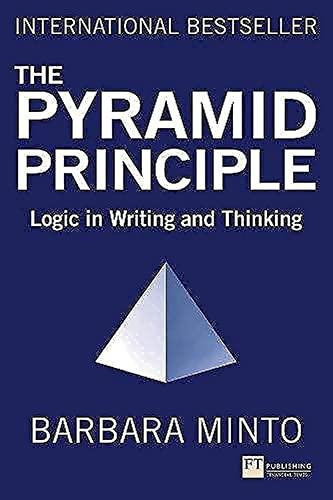Hanna Serednytska's Key Ideas from The Pyramid Principle
by Barbara Minto
Ideas, facts & insights covering these topics:
8 ideas
·2.15K reads
25
1
Explore the World's Best Ideas
Join today and uncover 100+ curated journeys from 50+ topics. Unlock access to our mobile app with extensive features.
The reasons why most people fail to write clearly
- Weaknesses of style, and it is notoriously difficult for a person who has completed the formal part of his education to change his writing style.
- Structure of the document: If a person's writing is unclear, it is most likely because the ordering of the ideas conflicts with the capability of a reader's mind to process them.
37
589 reads
The Magical Number Seven
There is a limit to the number of ideas you can comprehend at any one time.
The mind cannot hold more than about seven items in its short-term memory at any one time. Some minds can hold as many as nine items, while others can hold only five. A convenient number is three, but of course the easiest number is one.
39
505 reads
The Need to State the Logic
All mental processes (e.g., thinking, remembering, and problem solving) apparently utilize this grouping and summarizing process, so that the information in a person's mind might be thought of as being organized into one giant conglomeration of related pyramids.
If you think about communicating to that mind, you can see that the problem is ensuring that what you say will fit somewhere into the existing pyramids.
32
453 reads
The Vertical Relationship
The vertical relationship serves marvelously to help capture the reader's attention. It permits you to set up a question/answer dialogue that will pull him with great interest through your reasoning.
What you put into each box in the pyranmid structure is an idea. An idea is a statement that raises a question in the reader's mind because you are telling him something he does not know.
The way to ensure total reader attention, therefore, is to refrain from raising any questions in the reader's n1ind before you are ready to answer then1.
38
405 reads
The Top-Down Approach
Fill in the top box
1. What Subject are you discussing?
2. What Question are you answering in the reader's mind about the Subject"?
3 What is the Answer?
Match the Answer to the introduction
4. What is the Situation?
5. What is the Complication?
2. Do the Ouestion and Answer still fol!ow?
Find the key line
6. What New Ouestion is raised by the Answer·"?
7. Will you answer it deductively or inductively?
7. If inductively, what is your plural noun?
Structure the support points
8. Repeat the Question/Answer process at this levei.
15
55 reads
The Bottom-Up Approach
You can work out the ideas from the bottom up by following a 3-step process.
1. List all the points you think you want to make.
2. Work out the relationships between them.
3. Draw conclusions.
15
52 reads
Where Do You Start the Situation?
The key characteristic of all opening Situation sentences is that they anchor you in a specific time and place, and thus establish the base for a story to come.
You begin writing the Situation by making a statement about the subject with which you know the reader will agree, because you are telling him something that he knows to be, or will accept as, true. If you find you don't want to begin by making a statement about the subject, then either you have the wrong subject, or you're starting in the wrong place to discuss it.
14
48 reads
What's a Complication?
Using the previously established truth about the subject as its starting point, the Complication goes on to tell what happened next in the story that inevitably leads to a Question.
- Have a task to perform - Something stops us from performing that task - What should we do?
- Have a problem - Know the solution - How do we implement the solution?
- Have a problem - A solution has been suggested - Is it the right solution?
- Took an action - Action didn't work - Why not?
14
48 reads
IDEAS CURATED BY
An effective communicator and business analyst with an inquisitive mind, strong analytical, problem-solving, and decision-making skills
Discover Key Ideas from Books on Similar Topics
24 ideas
Essential gen-z & alpha slang explained pt. II
Jaydone Films
12 ideas
Read & Learn
20x Faster
without
deepstash
with
deepstash
with
deepstash
Personalized microlearning
—
100+ Learning Journeys
—
Access to 200,000+ ideas
—
Access to the mobile app
—
Unlimited idea saving
—
—
Unlimited history
—
—
Unlimited listening to ideas
—
—
Downloading & offline access
—
—
Supercharge your mind with one idea per day
Enter your email and spend 1 minute every day to learn something new.
I agree to receive email updates
